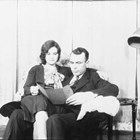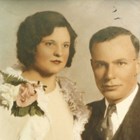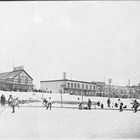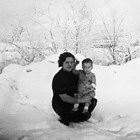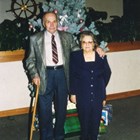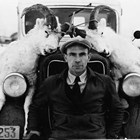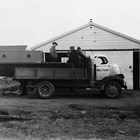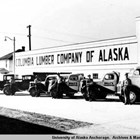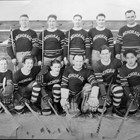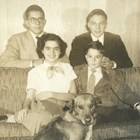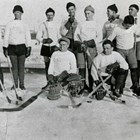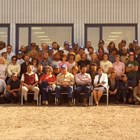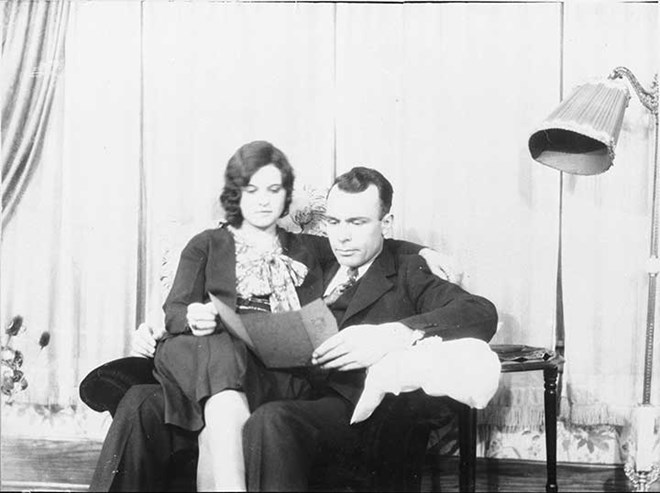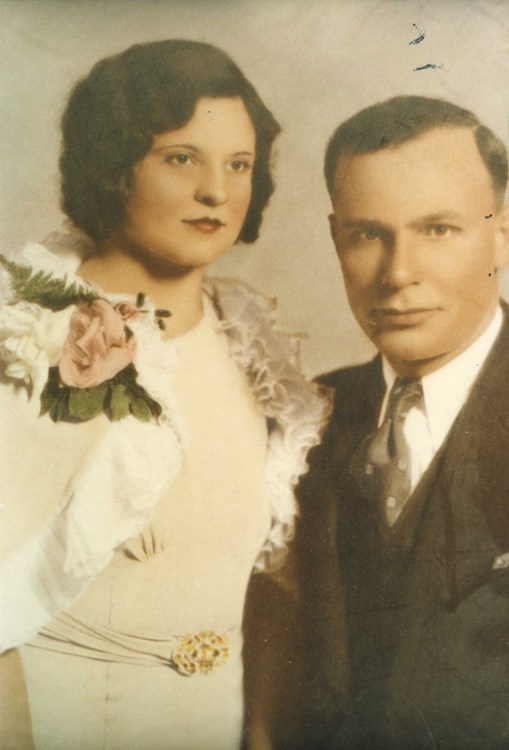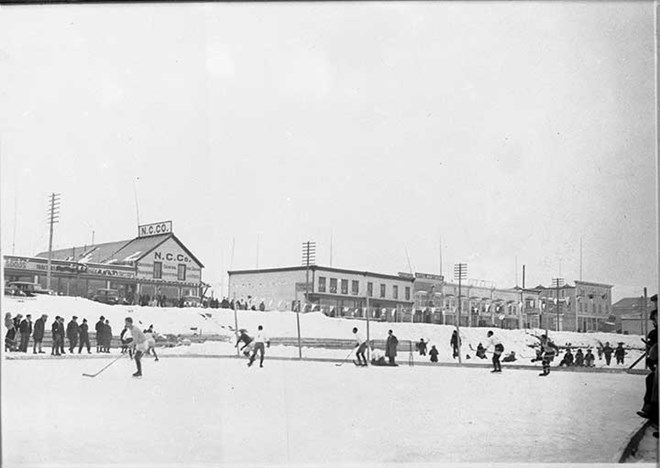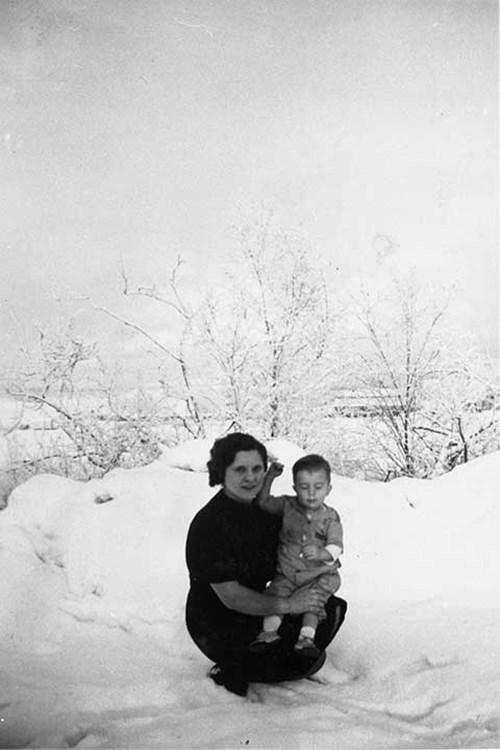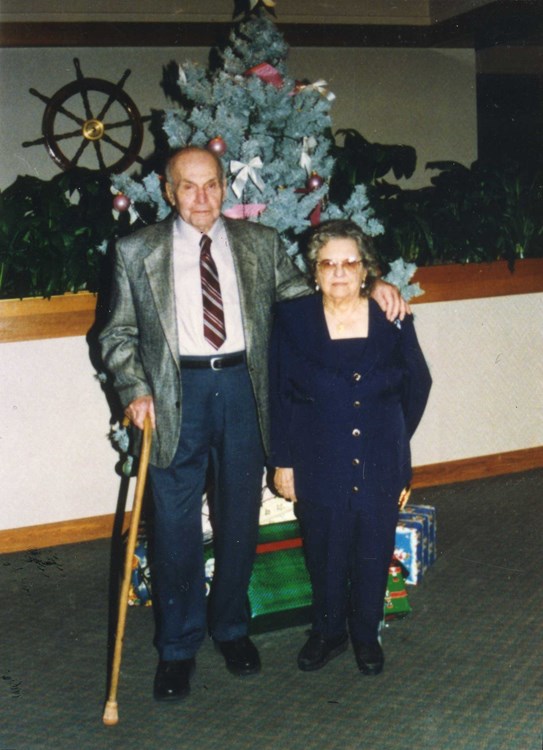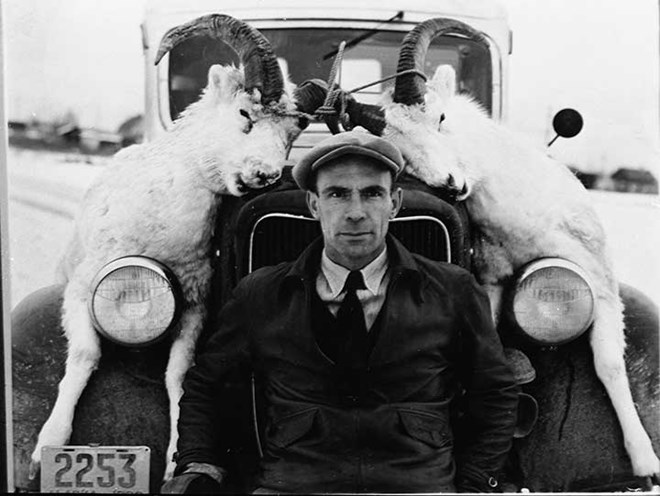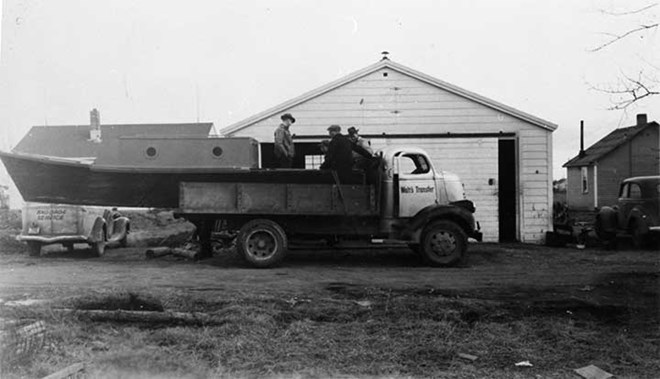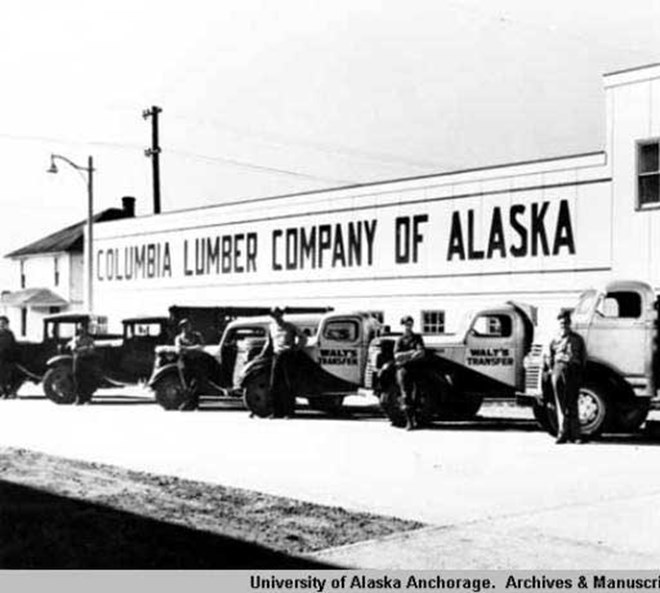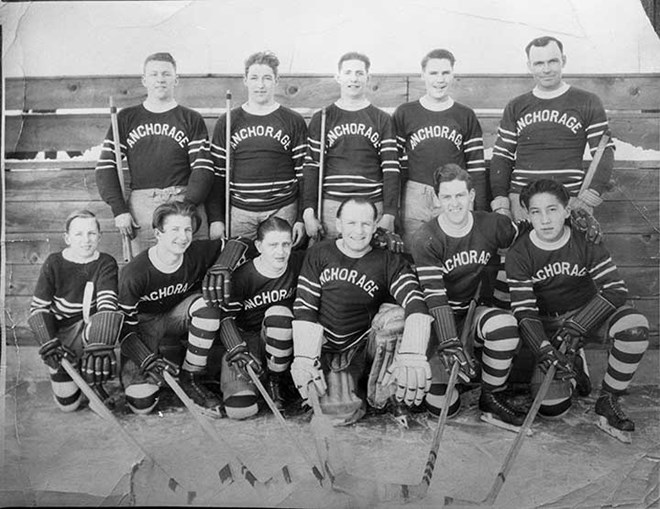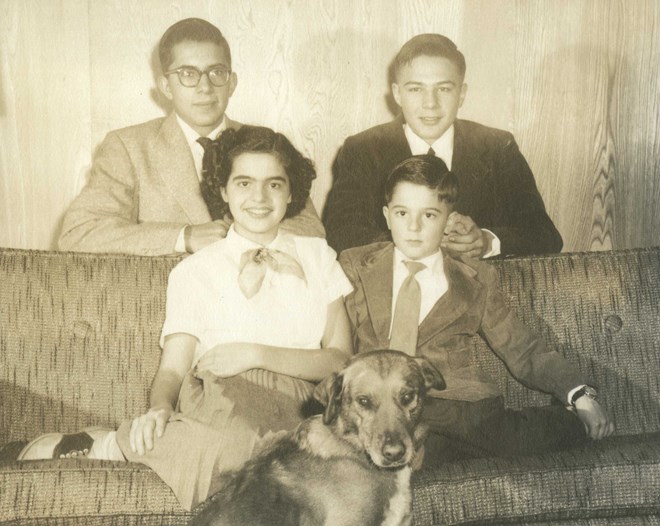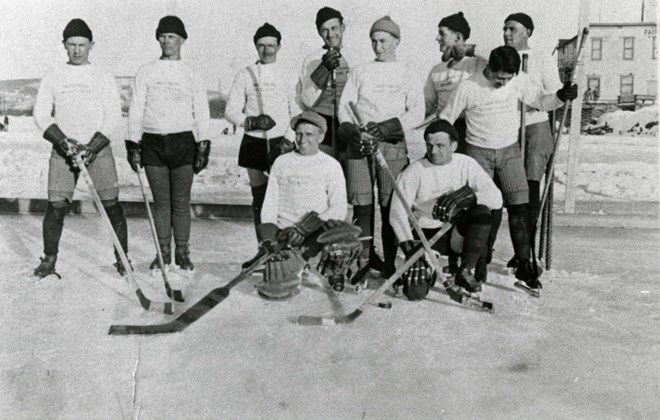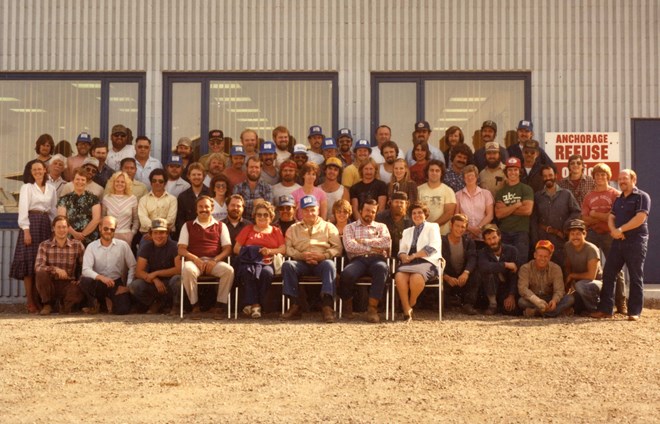Culhane, Thomas "Tom"
1903-1997 | Laborer, Businessman, Sportsman, and City Council Member
In the early 1990s, Thomas “Tom” and Rena Culhane owned two prosperous Anchorage businesses—Anchorage Refuse, Inc., and the Anchorage Recycling Center. Anchorage Refuse, Inc. picked up trash in Anchorage and Eagle River. The Anchorage Recycling Center, the city’s largest recycling plant, served Anchorage, the Kenai Peninsula, and Fairbanks more than a decade by collecting and processing tons of newsprint, cardboard, office paper, aluminum, plastic bags, and other materials, then shipping most of it out of state to companies that used it to make a wide range of paper products and other goods. The Anchorage Recycling Center is still located on Rosewood Street, off of Dowling Road. Together, both operations employed about 130 people.
Thomas Culhane was a Canadian immigrant who, with his wife Rena of Detroit, Michigan, came to Alaska in the early 1930s. They built up two separate thriving businesses, one based on hauling freight and handling fuel, and the second hauling refuse. In 1935, they purchased Walt’s Transfer Company of Anchorage and operated it under that name until 1945, when it was changed to Arctic Fuel & Appliance Company. Arctic Fuel was sold in 1968 at which time they purchased Anchorage Refuse Company, which became the largest garbage company in Alaska. In 1997, the Culhane family sold Anchorage Refuse, Inc. and its subsidiary, Eagle River Refuse, Inc. to USA Waste Services, Inc., of Houston, Texas, a subsidiary of USA Waste Management Inc.1
Early Years: Canada to Alaska
Thomas Culhane was born of Irish ancestry on December 18, 1903, on a farm near Renfrew, Ontario, located on the Bonnechere River, sixty-two miles west of Ottawa. He was one of nine children of Thomas Culhane and Bridget O’Brien Culhane. His father, Thomas, owned a farm in the rural Rainy River District.2 His grandfather, Dan Culhane, emigrated from Ireland in the 1800s. According to family lore, his grandfather received a cow, a plow, and 160 acres of land from the Canadian government after his arrival.3
In 1924, the junior Culhane was living in Renfrow, Ontario, Canada.4 He came to the United States about 1929, entering the port of Detroit, Michigan. In Detroit, he found work as a tire builder with the U.S. Rubber Company in the heavy duty department, where only truck tires were built. Truck tires at this time were made by piece work and required a lot of skilled hand labor to build. After struggling through tough working days in a Detroit wracked by labor turmoil and layoffs, he was unable to get steady work. One of his friends read a book about Alaska, with details about the Territory’s great outdoors, its hunting and fishing, and gold. Culhane and three of his friends decided to leave, saying: “Let’s get the hell out of Detroit and go to Alaska,” and “When do we take off?”5
Life in Alaska
In June 1932, Culhane and three co-workers made preparations for their Alaska trip. They bought a Hamilton touring car for $250, plus two tents, sleeping bags, cooking gear, and a gas stove. After their arrival in Seattle, they purchased steerage tickets, at $50 each, to Seward on the Alaska Steamship Alaska, and six days later landed there.6 In Anchorage, Culhane obtained a temporary, three-month summer job on a work gang, at 62.5¢ per hour, with the Alaska Railroad. He worked odd jobs. His three friends found jobs in Fairbanks with the Fairbanks Exploration Company, the local subsidiary of the U.S. Smelting, Refining, and Mining Company.7
In 1933, Thomas Culhane married Rena LaJambe, whom he had met a few years earlier in Detroit. She came by ship to Alaska and met her fiancé, Thomas Culhane, in Seward on December 24, 1933. On December 26, they were married in Seward. Born on June 24, 1907, in Brooks, Minnesota, Rena was the oldest daughter of Gasper and Adelin LaJambe. Her father, Gasper, was born in Montreal, Quebec of French Canadian ancestry. Her mother, Adelin Langlois LaJambe, had been born in France. She was the oldest of eleven siblings. When Rena was a girl, her family emigrated from Canada and moved to Detroit.8
The Culhanes relocated to Anchorage to find work and establish their home. They rented a small cabin on Fourth Avenue, for $20 per month, owned by John and Marie Bagoy. The cabin had a well, pump, and an outdoor privy. Rena was hired by John Meyer’s North Pole Bakery and Culhane “scrounged all the Alaska Railroad jobs I could get.”9 During her first three years with the bakery Rena saved $100, which the couple used as a down payment to buy Walter Teeland’s trucking company, Walt’s Transfer, in 1937.10
Walt’s Transfer
The trucking company, Walt’s Transfer, consisted of two trucks, a 1932 General Motors combination flat bed and dump truck, and a 1932 Ford one and a half ton flatbed.11 Culhane delivered coal and wood, and hauled “anything he could move.”12 The purchase price for Walt’s Transfer was $2,500. Later, Culhane recalled that Edgar Tarwater of the Bank of Alaska loaned him the money when the Culhanes had virtually no collateral.13 The Culhanes moved into a small apartment behind the trucking company office. Rena quit the bakery and worked in the company office and cared for their infant son, John, born November 11, 1937.14
Anchorage City Council (1942-1944)
World War II dominated Culhane’s service on the Anchorage City Council. In April 1942, he was elected to a two year term (1942-1944).15 During his term in office, the city received federal funds to improve the city water supply16 and expanded electrical lines and power outside the city boundaries. The city council approved the hiring of a “general supervisor” to assist the mayor and council (the forerunner of a city manager). Largely through the personal efforts of Mayor William “Bill” Stolt, an electrician, the voters approved $1,250,000 in general obligation bonds to purchase the Anchorage Light and Power Company, saving the taxpayers substantial sums in subsequent years.17
Entry into the Fuel, Refuse, and Recycling Businesses
In 1945, the Culhanes moved out of the trucking business and re-established themselves as the Arctic Fuel and Appliance Company, selling propane, diesel fuel, and stove and furnace oil.18 In the early 1960s, the family sold this business to Standard Oil and then bought and developed “a small rundown company called Anchorage Refuse.”19 Several of the Culhane children were involved with the Anchorage Refuse Company. Their eldest son, John “Jack” Culhane (1937-1991), expanded the company by buying Eagle River Refuse, Inc., and starting Anchorage Recycling. In 1985, the Anchorage Recycling Center was purchased. Their second oldest son, Thomas R. Culhane, became chairman and chief executive after his brother John died in 1991, and bought out a garbage hauling company in Seward. Thomas arranged the sale of the company to USA Waste Services, Inc. in 1997, a year after his father, John Culhane, died.20
Activities in Anchorage Community
Over the years the family moved several times, from the Bagoy cabin to the apartment behind the trucking firm, to a house on Ninth Avenue and, finally in 1962, to a home on Boniface Parkway. Rena loved gardening, and was known for her flowers at the Ninth Avenue house and for her vegetable garden at the Boniface home. She also loved to cook, and her obituary notes that “No one ever left her house hungry."21 She also won several prizes at local art exhibits for her paintings.22
Culhane played hockey and was a member of the team that represented Anchorage at the first Winter Carnival in Fairbanks in 1935 (the Anchorage team lost all their games).23 The following year, Culhane was still on the first string of the hockey squad in February when Anchorage hosted a number of teams from around the Territory (the Fairbanks squad drubbed Anchorage again, 14-2). This winter event grew quickly into what continues as the Anchorage Fur Rendezvous. Culhane also enjoyed hunting and fishing. By the time World War II had begun, he had learned to fly, had his own airplane, and had greatly enjoyed that past-time. As Rena put it, “He went hunting a lot, but often this was just an excuse to go flying.”24
The Culhanes had a recreational cabin north of Anchorage at Lost Lake, and in 1945 began a tradition of having large Fourth of July picnics there. Trap shooting was a major component of the event, and the person with the best score each year got to scratch their name onto a battered trophy that one of the family members had found in the trash.25
One of the Culhane’s neighbors and close friend at Lost Lake was Elmer E. Rasmuson, who was a fellow hunter and airplane pilot, and a prominent banker. The Rasmusons were regular attendees at the Fourth of July picnic, and the Culhanes did business with the Bank of Alaska, later the National Bank of Alaska, owned by the Rasmusons. The two men and their sons often hunted together. Elmer Rasmuson wrote: “Tom had a limited formal education but he had a native shrewdness that enabled him to sense a good deal, including the purchase of strategic real estate.” Rasmuson appreciated that Culhane had a “ready grin and a chuckle for all occasions.”26
Legacy
The Culhanes were active in the Catholic Church in Anchorage, and they were long-time members of the Pioneers of Alaska.27 Of their lives in Alaska, Culhane expressed these thoughts: “Living in Alaska has been great. Though I didn’t realize it then, the smartest move I ever made was leaving Detroit back in the 1930s to come North and merge our lives with the world’s greatest people—Alaska’s sourdoughs.”28
Thomas Culhane died in 1997, aged 94; Rena died in 2009, aged 102. The couple are buried in the Catholic Tract of Anchorage Memorial Park Cemetery with son John "Jack" and the Culhane grandchildren Patrick and Katherine.29
Endnotes
- Stan Jones, “Anchorage Refuse, Inc., Sold – Houston-based Company says it Plans no Immediate Changes,” Anchorage Daily News, October 17, 1997, E-1; and “City Recycling Center Sold – Midwestern Buyer Plans to Expand,” Anchorage Daily News, December 15, 1998, E-1.
- According to primary sources, Thomas Culhane was born near Renfrew, Rainy River District, Ontario, Canada, on December 18, 1903. It is doubtful that his place of birth was in the village of Ferguslea, as stated in secondary sources. For Renfrew, Ontario, as place of birth, see: (1) Thomas Culhane, Rainy River District, Ontario, Canada, Canadian Births and Baptisms, 1661-1959, database, FamilySearch; https://familysearch.org/ark/61903/1:1:FLKR-PJ3 (accessed October 14, 2015); (2) Tom Culhane to Bob Renkert, Pioneers of Alaska, March 8, 1993, File: Tom Culhane; Bagoy Pioneer Family Files (2004.11), Box 5, Atwood Resource Center, Anchorage Museum at Rasmuson Center, Anchorage, AK; and (3) entry for Tom and Rena Culhane, Fond Memories of Anchorage Pioneers, Volume 1 (Anchorage: Pioneers of Alaska, Igloo 15, Auxiliary 4, 1996), 43. Three secondary sources which list the village of Ferguslea as his place of birth are: (1) Thomas Culhane’s obituary, Anchorage Daily News, June 2, 1997, D-3; (2) John P. Bagoy, Legends & Legacies, Anchorage 1910-1935 (Anchorage: Publications Consultants, 2001), 339; and (3) Obituary, “Tom Culhane,” U.S., Find a Grave Index [database on-line], http://ancestry.com (accessed August 29, 2015).
- Entry for Rena and Tom Culhane, Fond Memories of Anchorage Pioneers, Volume 1, 43.
- Thomas Culhane, List or Manifest of Passengers Applying for Admission, Port of Detroit, Michigan, March 24, 1924, National Archives Microfilm Publication M1464, Manifests of Passengers Arriving at St. Albans, VT, District through Canadian Pacific and Atlantic Ports, 1894-1954, Roll 498, U.S., Border Crossings from Canada to U.S., 1895-1956 [database on-line], http://ancestry.com (accessed August 29, 2015).
- Fond Memories of Anchorage Pioneers, Volume 1, 43.
- Tom Culhane to Bob Renkert, March 8, 1993. Almost sixty years later, it appears that Culhane misremembered the steamer as the Yukon. There is a caption on a photograph in the Culhane Family Photographs, 1903-1993 (HMC-0096), in Archives and Special Collections, Consortium Library, University of Alaska Anchorage, indicates that Culhane and his three friends came to Alaska on the Alaska in 1932. These two sources mistakenly give the Yukon as the name of the ship: (1) Tom Culhane to Bob Renkert, March 8, 1993, 2, File: Tom Culhane; Bagoy Pioneer Family Files (2004.11), Box 5, Atwood Resource Center, Anchorage Museum at Rasmuson Center, Anchorage, AK; and (2) Fond Memories of Anchorage Pioneers, Volume 1, 43.
- Tom Culhane to John Bagoy, March 8, 1993, 2-3, File: Thomas Culhane, Bagoy Pioneer Family Files (2004.11), Box 5, Atwood Resource Center, Anchorage Museum, Anchorage, AK.
- Tom Culhane to John Bagoy, March 8, 1993, 2-3, File: Thomas Culhane, Bagoy Pioneer Family Files (2004.11), Box 5; and Fond Memories of Anchorage Pioneers, Volume 1, 43.
- Fond Memories of Anchorage Pioneers, Volume 1, 43.
- Rena Culhane to John Bagoy, April 22, 1999, File: Thomas Culhane, Bagoy Pioneer Family Files (2004.11), Box 5, Atwood Resource Center, Anchorage Museum, Anchorage, AK; and Fond Memories of Anchorage Pioneers, Volume 1, 43.
- Rena Culhane to John Bagoy, April 22, 1999, 3, File: Thomas Culhane, Bagoy Pioneer Family Files (2004.11), Box 5, Atwood Resource Center, Anchorage Museum, Anchorage, AK; and John P. Bagoy, Legends & Legacies, Anchorage 1910-1935, 340.
- John P. Bagoy, Legends & Legacies, Anchorage 1910-1935, 340.
- Tom Culhane to Bob Renkert, March 8, 1993, File: Thomas Culhane; Bagoy Pioneer Family Files (2004.11), Box 5, Atwood Resource Center, Anchorage Museum, Anchorage, AK.
- Rena Culhane to John Bagoy, April 22, 1999, File: Thomas Culhane, Bagoy Pioneer Family Files (2004.11), Box 5, Atwood Resource Center, Anchorage Museum, Anchorage, AK.
- Minutes, April 15, 1942, Anchorage City Council Minutes, Volumes V-VI, May 7, 1941-June 4, 1948, (microfilm edition, Alaska Collection, Z.J. Loussac Library, Anchorage Public Library, Anchorage, AK.
- Minutes, April 27 1942, Anchorage City Council Minutes, Volumes V-VI, May 7, 1941-June 4, 1948.
- Kristy Hollinger, The Early Electrification of Anchorage, edited by Glenda R. Lesondak (Fort Richardson, AK: Natural Resources Branch, U.S. Army Alaska; Fort Collins, CO: Center for Environmental Management of Military Lands, 2002), 43-44;Terrance Cole and Elmer E. Rasmuson, Banking on Alaska: The Story of the National Bank of Alaska, Volume 1: A History of NBA (Anchorage: National Bank of Alaska, 2000), 158-162; and Michael Carberry and Donna Lane, Patterns of the Past: An Inventory of Anchorage’s Historic Resources (Anchorage: Community Planning Department, Municipality of Anchorage, 1986), 123.
- Guide to the Culhane Family Photographs (HMC-0096), Archives and Special Collections, Consortium Library, University of Alaska, Anchorage; and John P. Bagoy, Legends & Legacies, Anchorage, 1910-1935, 341.
- Rena Culhane to John P. Bagoy, April 22, 1999, 1, File: Thomas Culhane, Bagoy Pioneer Family Files (2004.11), Box 5, Atwood Resource Center, Anchorage Museum, Anchorage, AK.
- Stan Jones, “Anchorage Refuse Inc. Sold – Houston-Based Company says it Plans no Immediate Changes,” Anchorage Daily News, October 17, 1997, E-1.
- Obituary, Rena Culhane, Anchorage Daily News, September 12, 2009, A-9.
- Rena Culhane to John P. Bagoy, April 22, 1999, File: Thomas Culhane, Bagoy Pioneer Family Files (2004.11), Box 5, Atwood Resource Center, Anchorage Museum at Rasmuson Center, Anchorage, AK.
- “Anchorage Good-Will Delegation Back Home from Ice Carnival,” Anchorage Weekly Times, March 14, 1935, 6; and “Northern Players Win 14-2,” Anchorage Weekly Times, February 21, 1936, 3.
- Rena Culhane to John P. Bagoy, April 22, 1999, 1, File: Thomas Culhane, Bagoy Pioneer Family Files (2004.11), Box 5, Atwood Resource Center, Anchorage Museum, Anchorage, AK.
- Rena Culhane to John P. Bagoy, April 22, 1999, 2, File: Thomas Culhane, Bagoy Pioneer Family Files (2004.11), Box 5, Atwood Resource Center, Anchorage Museum, Anchorage, AK.
- Elmer E. Rasmuson, Banking on Alaska: The Story of the National Bank of Alaska, Volume II, Elmer’s Memories (Anchorage: National Bank of Alaska, 2000), 275-277.
- Obituary, Tom Culhane, Anchorage Daily News, June 2, 1997, D-3.
- Fond Memories of Anchorage Pioneers, Volume 1, 44; and Tom Culhane to Bob Renkert, March 8, 1993, 3, File: Thomas Culhane, Bagoy Pioneer Family Files (2004.11), Box 5, Atwood Resource Center, Anchorage Museum, Anchorage, AK.
- John P. Bagoy, Legends & Legacies, Anchorage 1910-1935, 341.
Sources
This entry for Thomas Culhane originally appeared in John Bagoy’s Legends and Legacies, Anchorage, 1910-1935 (Anchorage: Publications Consultants, 2001), 339-341. See also the Thomas Culhane file, Bagoy Family Pioneer Files (2004.11), Box 2, Atwood Resource Center, Anchorage Museum at Rasmuson Center, Anchorage, AK. Some photographs are courtesy of the Culhane family. Note: edited, revised, and substantially expanded by Walter Van Horn and Bruce Parham, October 7, 2015.
Preferred citation: Walter Van Horn and Bruce Parham, “Culhane Thomas ‘Tom’,” Cook Inlet Historical Society, Legends & Legacies, Anchorage, 1910-1940, http://www.alaskahistory.org.
Major support for Legends & Legacies, Anchorage, 1910-1940, provided by: Anchorage Museum at Rasmuson Center, Atwood Foundation, Cook Inlet Historical Society, and the Rasmuson Foundation. This educational resource is provided by the Cook Inlet Historical Society, a 501 (c) (3) tax-exempt association. Contact us at the Cook Inlet Historical Society, by mail at Cook Inlet Historical Society, Anchorage Museum at Rasmuson Center, 625 C Street, Anchorage, AK 99501 or through the Cook Inlet Historical Society website, www.cookinlethistory.org.
